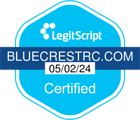Recovering from marijuana addiction is complex and requires a thoughtful approach. Finding the right rehabilitation program is crucial. Consider program types, personalized treatment plans, location, cost, and the facility’s credibility and staff qualifications. Each step toward finding the right program brings us closer to recovery and better health.
Acknowledging Your Marijuana Addiction
Recognizing your marijuana addiction is the paramount first step toward setting your life back on a healthier path. This fundamental process is referred to as addiction recognition. It is an essential component of recovery, without which, any attempts to seek help or rehabilitation can be futile. The importance of self-realization in this situation cannot be overstated.
Addiction recognition is a highly personal journey that may take time, introspection, and often, a fair share of heartache. It involves acknowledging the negative impacts of marijuana use on your health, relationships, productivity, and overall quality of life. This process also requires a keen understanding of the difference between casual or recreational use and dependency, which often blurs, leading to self-denial and procrastination in seeking help.
Realizing that you have a problem is just the beginning of the journey to recovery. Understanding the impact of the problem is important. Embracing this truth can motivate you to seek professional help. It’s a challenging but critical journey that sets the stage for rehabilitation.
Understanding Different Rehab Programs
Upon acknowledging your marijuana addiction, the next important step is to navigate the plethora of rehabilitation programs available, each tailored to meet specific needs and circumstances. However, constraints arise due to prevalent rehabilitation misconceptions, which can deter individuals from seeking the help they need.
Understanding the specifics of different programs is vital to overcoming these misconceptions and finding the right fit for you.
Outpatient and inpatient programs are the two main types of rehab programs. Outpatient programs allow you to continue with your daily life while receiving treatm. In contrast,ile inpatient programs are more intensive, requiring you to stay at the facility for the duration of the treatment.
Withdrawal management is an essential component of both programs. This entails medically supervised detoxification to manage withdrawal symptoms, which can range from mild to severe. The severity of withdrawal is contingent on factors such as the duration of usage and the individual’s overall health.
While the fear of withdrawal can be challenging, it’s important to remember that withdrawal management is designed to make the process as safe and comfortable as possible. Ultimately, understanding these elements of different rehab programs can empower you to make an informed decision about your recovery journey.
Importance of Personalized Treatment Plans
While understanding the basics of different rehab programs is important, it’s equally pivotal to contemplate the role of personalized treatment plans in recovery. These plans, typically made in collaboration with trained professionals, are designed to meet the unique needs and circumstances of each individual.
Therapeutic approaches are central to these personalized plans, with the aim of not only addressing the physical aspects of addiction but also the psychological and emotional dimensions. They incorporate a variety of evidence-based techniques such as cognitive-behavioral therapy, motivational enhancement therapy, and family therapy along with complementary therapies like yoga and mindfulness.
Individual counseling, another integral part of personalized treatment plans, serves as a confidential space for individuals to explore their substance use issues. It offers a safe environment to understand the root causes of addiction, learn coping strategies, and develop skills for maintaining long-term sobriety.
In essence, personalized treatment plans are not a one-size-fits-all solution. They provide a tailored approach that addresses the whole person, not just their addiction. It’s this attention to individual needs and circumstances that make personalized treatment plans an essential part of successful recovery from marijuana addiction.
Considering Outpatient vs. inpatient Care
In determining the most effective path for marijuana rehabilitation, a critical decision involves choosing between outpatient and inpatient care.
Both options come with their unique advantages and challenges, which will be explored in the following discussion.
Understanding Inpatient Care
When navigating through the complexities of inpatient care, it is essential to evaluate its advantages compared to those of outpatient programs when contemplating a marijuana rehab program. Inpatient care typically offers a more immersive and structured approach to treatment. This can be particularly beneficial for individuals experiencing severe marijuana withdrawal symptoms, as the round-the-clock care and supervision provided can help manage these symptoms effectively.
Inpatient care harnesses various therapeutic approaches to cultivate resilience and coping mechanisms. Cognitive-behavioral therapy, for instance, can help individuals recognize and alter negative patterns of thinking and behavior associated with marijuana use. Group therapies, on the other hand, foster a sense of community and support, making the recovery journey less challenging.
However, inpatient care isn’t without its challenges. It demands a significant time commitment and may disrupt personal, professional, and educational pursuits. Additionally, the costs associated with inpatient care are generally higher than outpatient programs. It’s important to weigh these factors and assess personal circumstances when considering inpatient care for marijuana rehab.
Benefits of Outpatient Care
Shifting the focus to outpatient care, it’s necessary to highlight its unique benefits as an alternative to the immersive environment of inpatient treatment.
Outpatient care offers a substantial level of flexibility, which can be pivotal in the patient’s recovery journey. This is exemplified by the advantage of flexible scheduling, enabling patients to maintain their daily routine while receiving treatment. This approach can be particularly effective for individuals who have work or educational commitments, or those with family duties, hence reducing the potential disruption to their lives.
Moreover, the role of family involvement in outpatient care cannot be overstated. Being in a familiar environment surrounded by loved ones can provide emotional support, reinforce treatment goals, and foster a sense of accountability. This familial network can motivate the patient to stay committed to their recovery, a key component in the pathway to sobriety.
In essence, outpatient care combines therapy and real-world experiences. Patients can apply learned coping strategies in real-life situations while still having access to professional help. This blend of independence and support can contribute significantly to the long-term success of marijuana rehabilitation.
The focus, then, is not just on treatment but also on sustainable recovery and reintegration into society.
Choosing Between Both Options
As we consider the benefits of both inpatient and outpatient care, the decision ultimately hinges on the individual’s unique circumstances, needs and recovery goals. Choosing from these rehabilitation alternatives should not be taken lightly as it can greatly affect one’s progress and psychological impacts.
Inpatient care is usually recommended for those with severe addictions or those who have relapsed before. This option provides a structured environment with round-the-clock medical supervision, reducing the risk of relapse.
Outpatient care, on the other hand, is suitable for those with mild to moderate addiction, who can’t afford to leave their work or family responsibilities. This approach allows for flexibility and integration of treatment into daily life.
Consider the cost. Inpatient care tends to be more expensive due to the residential and intensive nature of the program. Some insurance companies may cover the cost partially or fully, so it’s vital to check this beforehand.
Assess the support system. For outpatient care to be effective, a strong support system at home is crucial. Those lacking this may benefit more from inpatient care.
Evaluating Program Length and Structure
Evaluating the length and structure of a marijuana rehab program is an essential step in selecting the right treatment for an individual’s unique needs.
A thorough understanding of program duration offers insight into the time commitment required, while examining the program framework provides a clearer picture of the therapeutic journey ahead.
The importance of structure in these programs cannot be overstated, as it can greatly impact the effectiveness of the treatment strategy.
Understanding Program Duration
When considering a marijuana rehab program, it is important to understand the duration and structure, as these factors can greatly impact the effectiveness of the treatment. The length of stay can vary widely from one program to another, depending on the severity of the addiction, the presence of any co-occurring mental health disorders, and the individual’s personal needs and recovery goals.
Short-term programs typically last 30 days. These programs can be highly effective for individuals with milder forms of addiction or those who cannot afford to take extended time away from their responsibilities.
Long-term programs generally extend from 60 days to a year or more. They offer thorough, intensive treatment for individuals with severe or long-term addiction, complex withdrawal management issues, or multiple addiction triggers.
Outpatient programs allow individuals to continue their normal daily routines while participating in treatment. These programs may last for several weeks to several months.
Inpatient programs provide a structured environment away from addiction triggers and offer round-the-clock support, which can be vital in managing withdrawal symptoms.
Understanding the program duration is a critical step in choosing a rehab program that best fits the needs of the individual and ensures the highest chances of long-term recovery.
Assessing Program Framework
A thorough assessment of a marijuana rehab program’s framework, including its length and structure, is an important factor in determining its suitability to an individual’s unique needs and recovery goals. This evaluation should be detailed and consider both the program’s duration and design.
Rehabilitation stigmas often prevent people from seeking help, but a well-structured program can alleviate these concerns by providing a supportive, nonjudgmental environment. Additionally, an appropriately lengthy program allows for the gradual and sustainable development of coping mechanisms, making it more likely to result in a lasting recovery.
Legal implications are also critical to consider. Some programs may include legal support to help navigate any ongoing or potential legal issues related to the individual’s marijuana use. This support can be an important element of the framework, providing reassurance and reducing stress during recovery.
Importance of Structure
Recognizing the crucial role of a well-organized structure in a marijuana rehab program, especially regarding its duration and layout, is essential for attaining long-term sobriety and wellness. The structure of a program invariably shapes the rehabilitation environment and significantly influences the success rates.
An ideal structure should be tailored to meet individual needs and circumstances. This involves an in-depth evaluation of the program’s length and thoroughness of offerings. It’s critical to note that the effectiveness of treatment doesn’t solely depend on duration but also on the program’s coherence and consistency.
Consider these key points when evaluating the structure of a marijuana rehabilitation program:
1. A short-term program may be more intense, focusing on detoxification and immediate stabilization.
2. Long-term programs provide ongoing support and a deeper exploration of the underlying issues causing substance abuse.
3. A structured environment has a predictable routine, which can help foster stability and a sense of security.
4. An erratic or haphazard structure can hinder progress and diminish success rates.
Analyzing Location and Support Systems
In the journey toward recovery, one’s geographical location and surrounding support systems play a crucial role in the effectiveness of a marijuana rehab program. An individual’s proximity to the rehab facility amenities can greatly influence their commitment and resilience during treatment. For instance, a far-off facility might deter regular attendance and create unnecessary logistical challenges, weakening the program’s therapeutic value.
Moreover, community involvement is an underappreciated yet essential aspect of recovery. It gives the individual a sense of belonging and acceptance, which can greatly bolster their motivation for change. The presence of a strong and understanding community can serve as a safety net, minimizing the likelihood of relapse during vulnerable moments.
Additionally, the patient’s connection to their support system – family, friends, or even support groups – is crucial in reinforcing their resolve. An isolated individual might find the road to recovery riddled with obstacles, whereas a well-supported individual is better equipped to navigate these challenges.
Therefore, in the process of selecting a marijuana rehab program, careful consideration of the location and the strength of available support systems is essential.
Budgeting for Rehab: Cost Factors
Understanding the financial aspect of marijuana rehab programs is an important step, as cost factors can greatly impact the choice of treatment. A thorough budget evaluation can help you choose the right program and avoid financial stress during recovery.
There are several key considerations to keep in mind while budgeting for rehab:
1. Insurance coverage: Check if your health insurance covers substance abuse treatment. Policies vary, so it’s vital to understand what’s included and any out-of-pocket expenses you may incur.
2. Rehab scholarships: Some facilities offer scholarships or sliding-scale fees based on income, which can greatly reduce the cost of treatment.
3. Length of stay: The duration of the program directly impacts the overall cost. Longer stays mean higher costs but may also mean more thorough treatment.
4. Additional services: Extra services such as counseling, vocational training, or holistic therapies can add to the cost. Consider whether these are necessary and beneficial for your recovery.
Checking Facility Accreditation and Staff Credentials
With your budget considerations in place, shifting your attention to the credibility of the marijuana rehab facility becomes essential, specifically its accreditation status and the qualifications of its staff. Accreditation guarantees that the facility meets specific standards of quality and safety. It is a significant indicator of the facility’s dedication to providing high-quality care for substance abuse disorders.
Additionally, the staff’s credentials further validate the caliber of the rehab program. It’s important to evaluate whether the staff members are adequately licensed and certified. Their expertise in the field influences the effectiveness of the treatment and ultimately, the success of your recovery journey.
While exploring insurance coverage, it is worth noting that accredited facilities are more likely to be covered by insurance companies, further confirming their credibility. Furthermore, insurance can greatly alleviate the financial burden of treatment, making it more accessible.
Lastly, evaluating aftercare services is an integral part of appraising the facility’s credibility. A rehab program that offers extensive aftercare is likely to be more effective, as it demonstrates a long-term commitment to your recovery. Such services include continued counseling, support groups, and relapse prevention techniques, all essential elements in maintaining sobriety post-rehab.
Preparing for a Long-Term Recovery Journey
As you embark on the long-term recovery journey, preparation is crucial to ensuring a successful shift from a marijuana rehab program to maintaining sobriety in everyday life. This process involves creating a thorough aftercare strategy, ensuring family involvement, and adapting to an evolving lifestyle.
In preparing for this journey, consider the following steps:
1. Develop a complete aftercare strategy: Regular follow-up appointments, participation in community-based support groups, and continuous counseling. This approach helps solidify the skills you’ve learned during rehab.
2. Foster family engagement: Recovery is not a solitary journey. It’s important to involve family in the process. Their support can provide emotional strength and accountability.
3. Establish a routine: Creating a healthy routine that includes regular exercise, balanced meals, adequate sleep, and scheduled appointments can help manage cravings and reduce the risk of relapse.
4. Engage in positive hobbies: These can provide a distraction and help you develop new interests and coping mechanisms.
Preparing for a long-term recovery requires a thorough approach that incorporates aftercare strategies and family involvement. This preparation is crucial in shifting from a rehab program to a sober lifestyle.

Final Thoughts
Identifying a marijuana addiction and understanding the various rehab programs available are essential for initiating the recovery process. Personalized treatment plans, choosing between outpatient and inpatient care, and evaluating program length and structure are crucial considerations. Additionally, the location, support systems, cost factors, and facility accreditation carry significant weight. These steps, when meticulously followed, pave the way for a successful recovery journey from marijuana addiction.
If you or a loved one is grappling with addiction, remember that you don’t have to navigate this journey alone. BlueCrest Recovery is here to provide the help and support needed to move from the acknowledgment of powerlessness to a place of strength and healing. Do not hesitate to reach out to our team online or call today. Let our team guide you on your journey to recovery.
Frequently Asked Questions
What Are the Common Withdrawal Symptoms During Marijuana Rehab?
Common withdrawal symptoms during marijuana rehab include restlessness, irritability, mood swings, and sleep disturbances. Proper withdrawal management is essential to alleviate these psychological effects and promote a successful recovery process.
How Can Family and Friends Help During the Rehab Process?
Family and friends serve as crucial support networks during rehab, providing emotional encouragement. Their understanding, patience, and positivity can greatly contribute to the individual’s journey toward overcoming marijuana addiction.
Does Insurance Typically Cover Marijuana Rehab Programs?
Insurance coverage for marijuana rehab programs varies widely. Understanding your insurance’s limitations and potential rehab costs is important. Some plans may cover partial or full expenses, while others offer no coverage.
Are There Specific Rehab Programs for Teenagers Addicted to Marijuana?
Yes, there are specific rehab programs targeting teenagers. Such programs consider teenage susceptibility and the impact of peer pressure in their approach, providing therapy and education tailored to the unique challenges faced by adolescents.
What Lifestyle Changes Are Recommended Post-Rehab to Avoid Relapse?
Lifestyle changes, such as adopting healthy eating habits and engaging in regular exercise, are highly recommended to avoid relapse after rehab. These changes foster physical wellness and mental strength, which are essential for sustained recovery.


















